The First Homebuilt Falco in Germany
![]()
The First Homebuilt Falco in Germany |
|
by Hans Sonntag
This article appeared in the December 1995 issue of the Falco Builders Letter. |
I first saw a Falco when I was learning to fly in 1968 at Kassel, Germany. What a marvelous shape compared to most of the single-engine planes. Unfortunately the owner of this beauty was very toffee-nosed, and I couldn't persuade him to take me up for a few minutes, just to experience what it is like to be in a Stelio Frati designed plane.
But at least I knew that this plane had the approval of the German Federal Bureau of Aviation. This was quite important for the future possibility of owning a Falco. Some years later, when I was able to buy one, I learned that this plane was not available anymore in Europe. Again some years later, I spent a few days in San Francisco with a friend who is also interested in flying. By chance I opened one of his magazines and saw a tiny photograph with aligned airplanes which I liked from their silhouette. Below it I read: Send $12 to Sequoia Aircraft Corporation for more information. I did so and weeks later received a huge envelope with lots of information. I couldn't believe what I saw-it was all about my Falco.
With the idea that someone in Richmond could provide everybody with Falco spare parts we began looking for an old one or for a damaged Falco which could be rebuilt. We finally found one near Kassel, which our mechanic scorned when he looked at it-"It is a flying s-thouse", he said. This was the exact opposite of my feelings. I thought it was still in good shape. After the 5th takeoff, luckily with an experienced instructor, we realized something was wrong with the nose wheel, and we had to land with a retracted nose gear on a grass strip next to the runway. Both of us were unhurt. No problem with the damaged plane, spare parts are available in Richmond!
Wrong. This idea was a big mistake! The German 'FAA' permits only a replacement of spare parts from the original producer in an airplane licensed by German Federal Bureau of Aviation. My telephone bill went up to the sky because I phoned from Italy to the North Cape, from Spain to everywhere, to get the parts which had to be replaced. No way to get them. We even contacted Mr. Frati who provided us with a plan of the landing gear screwjacks, which was very generous.
Finally, with the agreement of the Federal Bureau of Aviation, a special maintenance company was authorized to make the parts, and the Falco could be repaired. I was very happy with it for a year and a half. But then I came back from a cross-country flight, and on extending the landing gear, I realized again that something was wrong with the nose gear. I told the controller about my problem and flew over the tower. The controller was the same one when we first landed the Falco on the grass strip with the landing gear problems. He said, "You have the same place to land as you did it the first time". So I did, and everything started all over again. After the Falco was repaired, I sold it because I thought two times were enough. I bought a Piper Arrow.
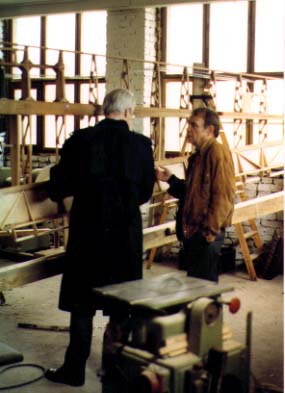
Hans Sonntag (right) with expert from England
What a difference! It was really boring to fly. Something reminded me of Sequoia Aircraft Corporation, so I sold the Piper and changed all the money into U.S. dollars. The second step was to convince my brother-in-law to build an airplane with me. The third one was to convince my sister to stay a little bit away from our place (mostly the whole weekends), so that we could build our Falco peacefully and undisturbed.
Then I raised the question with the Federal Bureau of Aviation about the regulations to build a Falco. After getting this information, I ordered all the kits available, and we started to build the tail as recommended in the construction manual. In the meantime we also convinced an official inspector to fulfill the regulations and to look regularly after our work.
The first serious glitch happened when I told my brother-in-law not to install the ribs at the first station of the stabilizer. I lost, and he glued the ribs in place at the right position. When the tail group was assembled with the fuselage, he understood the problem, and he had to take them out again. But we learned the lesson, and we followed the steps proposed in the manual as much as we could.
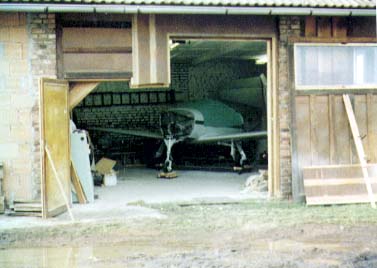
Sometimes the ambition came through to not follow the construction manual, sometimes without punishment. For example, when we came to the aileron/flap assembly we built it in a vertical position without a jig. The aileron/flap spar was fixed with all hinges at the aft wing spar and the corresponding ribs were then glued in and aligned with the wing ribs.
But not everything went smoothly. We had big problems bending the plywood to the desired radius because approved birch plywood for airplanes which we get here has five plies-which can stay in water forever without soaking the three inner layers. You have to be very patient when bending it, otherwise it will crack. Another problem arose when we installed the brake lines. There was no way to get an aluminum tubing in inch-sizes to correspond with the fittings.
Often there are idioms in the manual which are hard to understand, for example, what does 'squirt' mean? My dictionary gives explanations which don't fit anything.
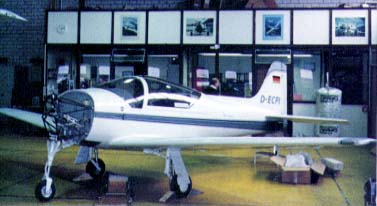
Also an unexpected trouble came up when a fire broke out in our first shop. All of the construction documents were burned up, but fortunately the tail section and all the other wooden parts were unaffected except the windshield, which was temporarily installed, and after the fire it was quite distorted. With the aid of an infrared heat lamp and a piece of shaped wood covered with felt, we managed to get it back in shape. Sequoia provided us with new plans and a construction manual.
The most inconvenient result of the fire was that we had to build a new shop, which we did on the same ground where an unused shed could be transformed into a workshop. But finally we made the Falco in three years and nine months time, and I am very proud to have kept on because the place where the Falco was built is far away from home. It is not much fun to drive 150 km every weekend. I am also proud to still own my ten fingers.
The 21st of November, 1994 was the last day in our shop. Part of the front of the shop had to be removed to get the plane out. The Falco was transported to Hannover Airport on a huge truck of a maintenance company. It was left in their "trouble corner". This was their name for a place in which they could work without being in a hurry. It should be renamed to "lucky or happy corner". The Falco was put together, and everything was inspected again. Finally when they finished, we got the required second expert opinion from our inspector to get a preliminary license from the Federal Bureau.
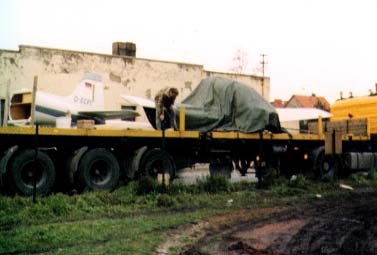
The remaining problem with the Falco is the noise pollution which has to be reduced to about 72 decibels to get it permanently licensed. This is the reason we installed a three-blade propeller and a IO-360-B1E with a restricted RPM to get the noise down. All this is not sufficient, but it seems possible to install very small mufflers in the exhaust system which fit inside the cowling.
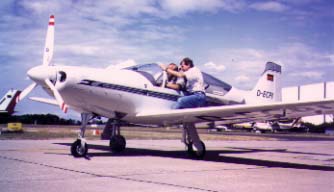
On August 14, the Federal Bureau of Aviation gave the dearly desired "green light" which means a preliminary license, and the plane was first flown by Rolf Hankers, an experienced test pilot. Everybody comments on this event more or less emotionally, for instance "with an IO-360 you could get a piece of wood in the air, and it will fly" and other nonsense. But the best news came from Rolf, who was very happy with his first experience. He tested it for more than nine hours.
A few days later on August 20, it was the big day for me. I had my first instruction in my new Falco, and I tell you it was an indescribable feeling. I felt quite comfortable because Rolf was sitting next to me acting as co-pilot. This feeling changed suddenly when he got out and told me to fly the plane to Kassel Airport without him. So much the more as he told me before I should not fly the approach at very low speed, because below about 60 kts it turns the other way around (over the left wing) without saying a word. I have to confess the stall strips are not yet in place.
I am not going to tell you more about my incredible emotions during the flight to Kassel and from the following 27 hours of experience. It will be an incentive for all Falco builders to do some efforts to finish their plane too in less time to get their own sensations.
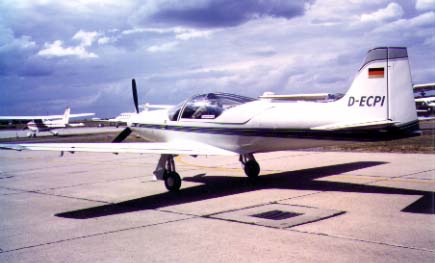
Coming back to the Falco, the color is papyrus white with stripes of gray and anthracite. The exterior is repeated in the inside, a gray carpet on the floor. The seats and side walls covered with alcantara, a very light leather-like synthetic material, also in gray and anthracite. In addition, it is equipped with a Century I, a King/Bendix transponder, two KX 155, hopefully very soon with a King GPS 35A, a Hoskins fuel totalizer, a four-cylinder EGT and an intercom. The empty weight with all this equipment is 587.23 kg (1294.63 lbs.), and the CG is between 1842 mm at takeoff and 1805 mm at landing.
What more should I say at the end of my report? To build your own Falco has something to do with masochism, but I certainly learned a lot about handicraft. I also learned to answer some questions posed from different people in different ways. Believe me, I don't want tomiss one minute of this experience.